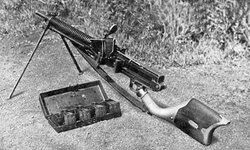ThomasP
Chief Master Sergeant
Hey Zipper730,
I do not know all of the history of the 37mm M4 gun, but this is what I have:
M4E1 used a 5-round clip (the 5 rounds were held in a stripper clip, and each 5-round clip was loaded individually into the loading tray, as shown in the photo I posted upthread) This was the gun fitted to the XFM-1 and YFM-1 prototypes.
M4E2 used a 15-round magazine (with the rounds in a disintegrating link belt, as below) I think the links and casings were ejected from the aircraft, but I am not sure.

M4E4 used a 30-round endless belt magazine (basically a 30-round flexible stripper clip, the belt moved along the inside of the bow shaped magazine - similar to a conveyer belt - with the rounds being stripped from the belt, fired, and the case ejected into a spent casing box below the gun)

The P-39C and some early P-30D used the 15-round magazine. As far as I know all P-39D-2 and later marks used the 30-round magazine.
I do not know all of the history of the 37mm M4 gun, but this is what I have:
M4E1 used a 5-round clip (the 5 rounds were held in a stripper clip, and each 5-round clip was loaded individually into the loading tray, as shown in the photo I posted upthread) This was the gun fitted to the XFM-1 and YFM-1 prototypes.
M4E2 used a 15-round magazine (with the rounds in a disintegrating link belt, as below) I think the links and casings were ejected from the aircraft, but I am not sure.
M4E4 used a 30-round endless belt magazine (basically a 30-round flexible stripper clip, the belt moved along the inside of the bow shaped magazine - similar to a conveyer belt - with the rounds being stripped from the belt, fired, and the case ejected into a spent casing box below the gun)
The P-39C and some early P-30D used the 15-round magazine. As far as I know all P-39D-2 and later marks used the 30-round magazine.

